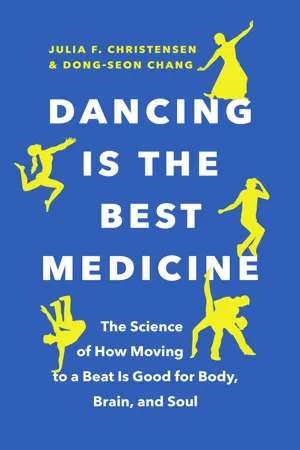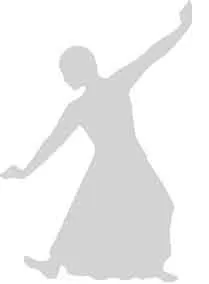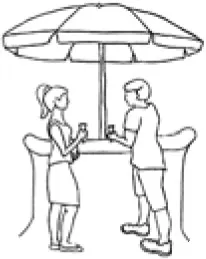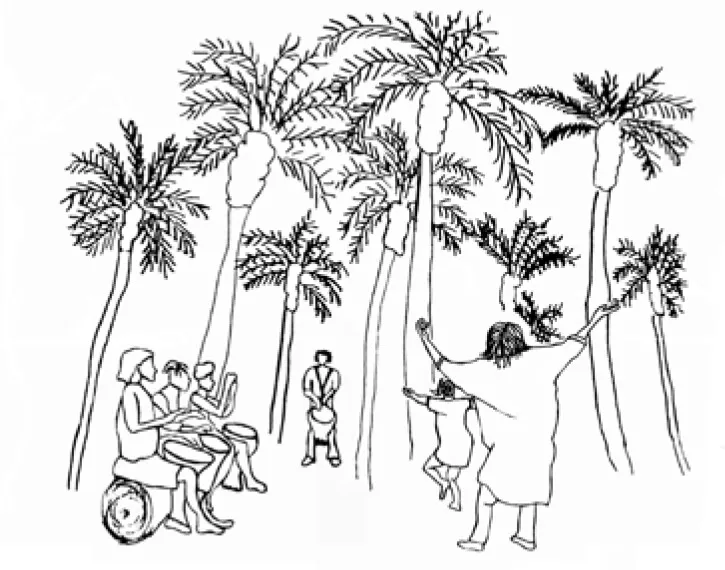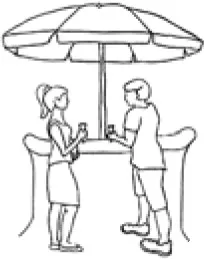The Success Story of Dance
In May 1927 the American pilot Charles Lindbergh made a nonstop solo flight from New York to Paris. Above the stormy Atlantic Ocean, Lindbergh and his single-engine Spirit of St. Louis were dancing in the clouds. Down below, in the clubs of Harlem, people were dancing too—and their dances were no less stormy! The Charleston, jazz dance, and the breakaway were the favorites of the day, but a new style was also taking over the floor. It was a combination of everything that had come before it, and its step sequence was the result of chance: in one of the many dance socials taking place all around the city, partners Mattie Purnell and George Snowden were dancing the breakaway, a swing dance that had originated in the African American community. As they let themselves be carried away by the music, a new step sequence emerged. Again, and then over and over again—as if the rhythm had taken control of their legs. Soon, the other dancers on the floor had formed a circle around them. Unable to take their eyes off the couple, they watched curiously and cheered them on. In the early hours of the morning, when a sweaty George Snowden was asked what he called this new dance, his eyes caught a glimpse of a newspaper account of Lindbergh’s transatlantic flight. Lindy Hops the Atlantic, the headline read. Casually, and with a big grin, Snowden replied, “Lindy Hop.” Lindbergh’s dance in the clouds had turned into a dance on the floor. A new hero and a new style of dancing had been born: Lindbergh and the Lindy Hop. (There are many different stories about how exactly the Lindy Hop came to be, but in each of them, Mattie Purnell, George Snowden, Frankie Manning, and Norma Miller play the central roles.)
What made this new dance particularly special was the option of dancing solo or as part of a couple. Alone with the elements and oneself—that’s a powerful experience. And for many, crossing the dance floor is just as nerve-racking as crossing the Atlantic must have been for Lindbergh. Dancing feels exciting, and it always leads us into uncharted territory, depending on the partner, the dance hall, or the music that happens to be playing. Dancing can be a ritual, a sport, an art form, a profession, a passion, or therapy. But above all else, dancing is an expression of feelings. Children dance to “Soft Kitty” while Grandma sways to folk songs in her seniors’ residence. A long-haired metal fan rocks with the beat at an open-air festival while a ballet dancer twirls on a city stage in her pink tutu. Everybody does it. Everybody dances.
Dancing has sunk its roots deep into all of us. As soon as we hear a familiar rhythm, we want to move, even if it’s just to bob our head. The desire to dance, it would seem, is rooted in our brain. As neuroscientists, we’d go so far as to say that the brain wants to dance! And dancing is probably as old as humanity itself. A quick look through human history reveals how important dancing has been for the development of our species, even though at first glance rhythmic movement appears pointless from an evolutionary perspective. Early humans inhabited a harsh world of deprivation and danger. It took a great deal of time and energy to provide sufficient food and ward off enemies, be they human or animal. Boredom did not trouble our long-ago ancestors, and when it got dark, they were in all likelihood exhausted from the work of the day. So why did they “waste” their hard-earned energy reserves on dance? Because make no mistake: dance they did!
Prehistoric humans danced in times of mourning and in times of joy; they danced to conjure rain, to appease the gods, and to stoke their rage toward their enemies. We can see how important dancing was to our ancestors when we look at their rock paintings—Stone Age graffiti, if you like. Four topics are regularly represented: animal and hunting scenes, family and property depictions, sexual behaviors—and dancing. And dancing was most likely practiced long before humans were capable of keeping records of any kind. In an interview with Der Spiegel, music cognition researcher Gunter Kreutz of the University of Oldenburg described dance as a by-product of the erect posture that human beings adopted and that contributed tremendously to the development of our cognitive abilities: “Perhaps humankind developed as much as it has thanks only to dance.”
When we look at evolutionary history, we find clear indications that it was only our own species, humans, that at some point started to make music. Of course, our ancestors didn’t relax in their caves to listen to Mozart’s Requiem on their ear-buds; for them, music always meant being active. It involved movement and an engagement with what was on their minds and in their hearts. Since prehistoric times, humans have been moving to rhythm or music to express with their bodies aspects of their lives and their everyday practices.
Unfortunately, no choreographies from the early days of humankind have come down to us; dance does not fossilize or leave behind musical instruments or other cultural artifacts that we can admire in museums. Dance disappears the moment it is danced—it remains only in the memory of the dancers and their audiences. Even so, the ritual dances of modern Indigenous peoples allow us a glimpse into the importance of dance for our ancestors.
Cultural and art historian Aby Warburg described the snake dances of the Pueblo Indians in the early twentieth century, intended to conjure rain. Tribesmen took the heads of live poisonous snakes into their mouths and held the reptiles between their teeth while they danced. The earth needs water, the thinking went, and because snakes are closer to the earth and hence to the powers of nature, they are better at communicating with the clouds than humans are. With the snakes in their mouths, the dancers were able to transfer the tribe’s message to the clouds: we people need rain.
Of course, we now know that these dances had absolutely no effect on the rain. But our ancestors—who existed without the benefit of scientific explanations for the phenomena of their daily lives—had no idea why it sometimes rained and other times did not. Why were there seasons? Would summer return? What if it didn’t? Would morning always follow night? And why were there sometimes horribly loud thunderstorms? Were they messages from furious gods?
For early Indigenous peoples, dance was a means of exerting control over the mysteries of their everyday lives. If we consider the uncertainties and insecurities they faced, we can understand why our ancestors developed strategies to give themselves a sense of control, and the feeling that they were able to do something to secure their tribe’s survival. Independently from each other, many Indigenous peoples created dances to honor or appease their gods, to prepare for the hunt or for battle, and to engage with the weather and influence the harvest. Dance, for them, was an important ritual.
Evidence that dancing bodies have always captivated our imagination can be found in prehistoric rock paintings, in the countless Google hits that popped up when Julia searched the term “dance,” and in the high ratings of television programs such as World of Dance and Dancing With the Stars. People all over the world—regardless of culture or background—move to the rhythm of music, and they do so from early childhood to advanced old age because dance is movement like no other. Dancing ranges from simple rocking movements to highly complex art forms such as classical ballet.
Dance is unique. Most movements have a purpose. In our daily lives we move in order to get from point A to point B, to complete a task, to communicate, or to have a particular impact on our environment. We nod or shake our head, close a door, wave, or point at something in order to make ourselves understood. Movement in sports, too, is goal-oriented: we overcome a particular distance in a certain amount of time, or we kick a ball into a net. Mostly, movement in sports is about competition—comparing ourselves to others and trying to do better than they do.
Dance, though, is different. Dance movements arise from within and are not concerned with what is happening around us; they do not care about any effect they might have on the world. Purposeless, they are an end in themselves, an outward expression of an inner state. The outstanding health effects are, for the most part, a completely unintended side-effect. We don’t need to think about doing anything in a particular way; when we let the music take control, the health effects just happen. Dancing is, by definition, a spontaneous movement to a rhythm. That impulse to follow the rhythm originates within us, and every person will respond in their own way. In order to throw a ball, we practice movements that are similar all over the world; few variants exist. But in order to dance to a particular piece of music, we can move in as many different ways as there are people in the world. Some skip and pulse to a strong beat while others lean toward flowing movements; some move mostly their arms, others their legs. Some close their eyes, others don’t. This freedom of expression is unique. Wolfram Fleischhauer describes this beautifully in his book Fatal Tango. A ballet dancer is searching for a tango dancer in Buenos Aires, a man with whom she had fallen in love in Germany and who had then left the country after their brief, passionate encounter. To find him, she watches dancers and approaches those whose movements are similar to his; she thinks they might have learned dancing from him. By studying his dance movements, she hopes to also discover his identity—a quest that sets off a suspense-filled, intriguing story.
No matter how hard it is to define the word dance, we know it when we see it. Dance may be a ritual with strict rules, a precise art form, or a sweat-inducing sport, but above all it is this: a feeling primarily related to our inner lives.
